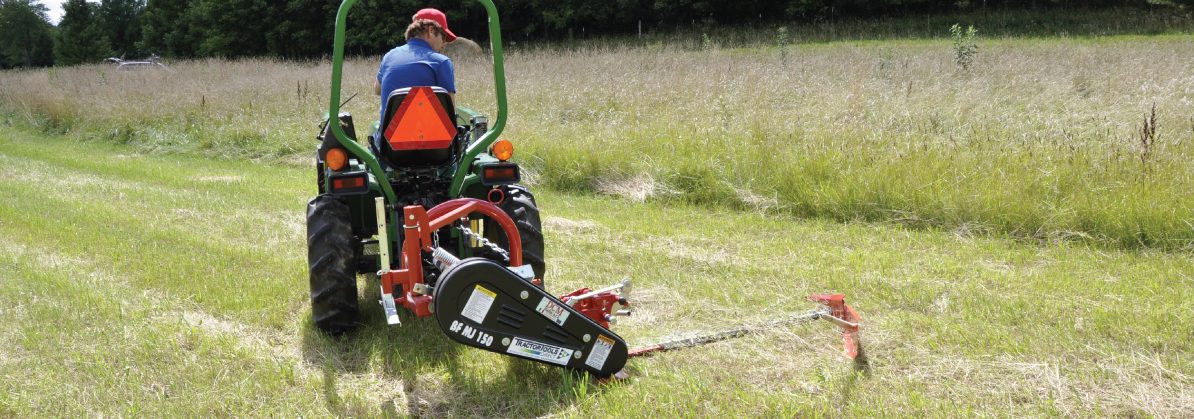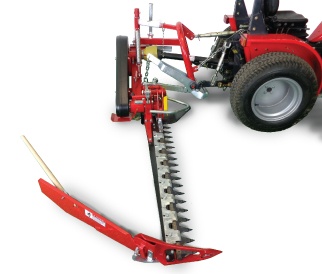When is a Sickle Bar Mower the Right Choice for your Operation?

In our effort to provide top-quality information to our customers to support them in their purchases, we want to continue our discussion of mower types. Last month’s blog/newsletter covered the pros and cons of the drum mower. This month we will examine the uses of the sickle bar mower and help you to determine if this type of mower might be the best match for your operation’s needs.

A sickle bar mower is the right choice when you need a lightweight machine for your small tractor, or when you are mowing light material in ditch banks and other irregular terrain. They cannot mow at the higher speeds of drum mowers and disc mowers, and they cannot handle heavy brush like a flail mower can. However, they excel at cutting at angles well above and below level.
Originally pulled by horses, the sickle bar mower was the first mechanical hay mower. The design is much the same today as it was then. The mower works with a reciprocating action, moving triangular blades back and forth between stationary guard fingers. Each back and forth action shears off any grass or vegetation that is between the stationary fingers. The action is the same as a set of barber’s clippers cutting hair. This type of mower can be used to cut hay as well as for other general light mowing duties. The best sickle bar mowers currently being produced use a double action where the guard moves in the opposite direction from the blades. This doubles the effective blade speed, and also greatly reduces machine vibration, making it quieter, more comfortable to use, and longer lasting.
Though a sickle bar mower’s design is a bit antiquated, its advantages are:
- Requires little horsepower. If you have a very low power tractor of 15 horsepower or less, this option will really be your only choice. Though we do carry very small drum mowers, if you have an older compact utility tractor like a Kubota 5000 or 6000 series, a sickle bar mower will be your best bet.
- Lighter weight. If your tractor is very lightweight, or has very little front weight, a sickle bar is the lightest weight hay mower and therefore your best (and safest) option. However, if you have at least 1,400 lbs. of weight, a subcompact drum mower will be your best best. Most subcompact tractors with front loaders meet this minimum weight requirement.
- Angled mowing capability. If you are mowing light material in ditch banks, sickle bars are the only hay mower style specifically designed to work below horizontal. If you're cutting anything but hay or light material, you should switch to a hydraulic offset flail mower.
- Less motion=less dust. While disc and drum mowers create a vortex of moving air across the blades, sickle bars have relatively little motion. As a result, less dirt will be cast into the air and your newly cut hay. This can be a disadvantage through if you need your hay to cure quickly, since the hay lands in a flat swath that can trap more moisture below.
That being said, the disadvantages of a sickle bar mower include:
- Forward speed. A sickle bar mower’s forward speed is much slower than disc and drum mowers. They can mow a wide swath, but maximum speeds are only about half of other designs.
- Less robust. Sickle bar mowers have lots of small, light-weight moving parts that are close to the ground. Hitting an obstruction with a sickle bar mower is more likely to cause catastrophic damage than with other types of mower. They cannot handle cutting thick material, which is likely to result in quick wear and/or damage.
- Clogging. They become easily clogged when working in very dense, lodged, or already cut material. Clogging is also more of a problem when blades begin to get dull.
- Cumbersome blade replacement. When blades become dull, replacing them usually requires special tools and mechanical know-how and can be time consuming and expensive.
- Repair expense. Damage due to hitting an unknown obstruction can be expensive to fix. The mower's many small parts must work together in perfect unison. Therefore, if one part becomes damaged, it is likely to result in cascading, expensive failure.
We at TTD know that choosing a mower can be a daunting task. There are so many choices available. Hopefully this article, along with last month’s article discussing drum mowers, has provided you with the information you need to make the most appropriate choice for your operation. Next month we’ll continue the series with a discussion of disc mowers.
Recent Posts
-
Farm Tax ID Explained: Benefits, Eligibility, and How to Apply
As the end of the financial year approaches, it's a great time for small farmer operators to rev …Nov 12th 2025 -
Rototillers vs. Power Harrows: Which Tool is Best for Your Soil?
Fall might seem like an odd time to talk about planting, but there really is no better time to t …Oct 27th 2025 -
Fall Hay Equipment Checklist: Prepare Your Machinery for Winter
After a busy and productive hay season, it’s easy to park your equipment in the barn and call …Oct 14th 2025




